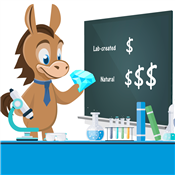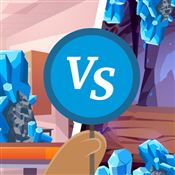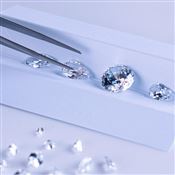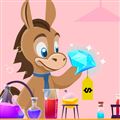Do Lab Created Diamonds Test as Real?
Lab-created diamonds are the same as natural diamonds. But do they test as real? Keep reading to learn if lab diamonds will pass a diamond tester.
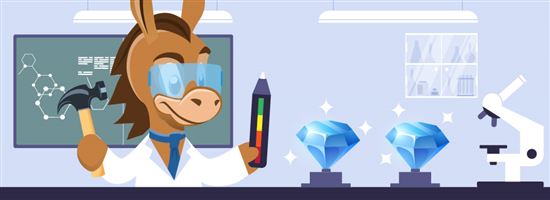 |
You've heard it many times: lab diamonds are real.
But what makes them real? How do they fare on diamond testers? How do they compare to natural diamonds?
Here's everything you need to know about testing and identifying lab diamonds.
Do Lab Diamonds Pass Diamond Testers?
Yes! Lab diamonds will pass a diamond tester and test as real diamonds.
They have the exact same properties as natural diamonds. These include thermal and electrical conductivity, which diamond testers use to identify diamonds.
However, some lab diamonds may test as moissanite. Keep reading to learn why that happens.
Lab diamonds are real diamonds. Both are made of pure carbon. So in terms of physical and chemical properties, they're the same. That's why jewelers and diamond testers can't detect them.
How Do Diamond Testers Work?
Diamond testers are handheld, pen-looking devices. They're usually used by jewelers to separate a diamond from its simulants.
Diamond testers identify a stone by measuring its thermal and/or electrical conductivity. This is because heat and electricity flow differently through different gemstones.
There are two main types of diamond testers. They depend on whether they test thermal or electrical conductivity:
- Thermal testers can separate diamonds from all diamond simulants, except moissanite. Both stones have high thermal conductivity. So thermal testers always mix them up.
- Electrical testers can separate diamonds from moissanite. Diamonds don't conduct electricity. But moissanite does.
Most diamond testers measure either just thermal or electrical conductivity. But there are also multi-testers that check both. These can separate diamonds from all simulants, including moissanite.
Do Lab-Grown Diamonds Test as Moissanite?
Most lab diamonds don't conduct electricity. But some can become electrically conductive, thus testing as moissanite.
Lab diamonds become electrically conductive when they contain trace amounts of boron. This is due to some methods in their production. Even natural diamonds can contain boron.
Boron usually results in diamonds looking blue.[1] That's why diamonds that test as moissanite look near-colorless, with a slight blue tint.
Do Diamond Simulants Test Real?
Diamond simulants won't pass diamond testers. Unlike lab-grown, simulants don't have the same properties as natural diamonds. That's except for moissanite in some cases.
Simulants are gemstones that only look like diamonds. But they're completely different stones.
Can Jewelers Tell Lab Diamonds?
Even jewelers can't tell lab diamonds through the naked eye. Traditional jewelers' tools, such as loupes and microscopes, are also often of no use.
An exception is when the stone has a laser inscription that says it's lab-grown. These inscriptions are viewable through jewelers' tools. They're a reliable way of confirming the stone's origin.
These laser inscriptions usually contain a word such as "created" and "lab grown." It's also followed by the stone's certificate number, which is searchable on the lab's website.
But jewelers can also invest in high-tech machines to detect lab-grown diamonds. One example is the DiaTrue machine from OGI Systems. However, these machines can be super-expensive. So not all jewelers have them.
How to Know for Sure if It's a Lab Diamond or a Natural Diamond?
Certificates
The easiest way to tell a diamond's origin is by checking its certificate. Whether lab-grown or natural, you should only buy a diamond if it's certified.
Diamond certificates tell a stone's qualities as assessed by a gem lab. Most lab diamonds are certified by the IGI and GCAL. The GIA is the most reputable diamond grading lab. Jewelers don't send lab diamonds there because GIA certificates are more expensive.
Certificates are essential because they protect buyers from fraud. When a diamond is certified, you know its source and quality. And that it's not a lower-quality diamond or a simulant.
Gem lab tests
If a diamond has no certificate, the only way to confirm its origin is by sending it to a gem laboratory. These labs use high-tech machines to perform tests that can detect a lab diamond.
- Fluorescence and phosphorescence: These tests check how a stone reacts to UV light. Lab diamonds and natural diamonds glow in different ways and colors when exposed to UV light.
- Growth patterns: Growth patterns indicate how a diamond was formed. Lab diamonds grow inside laboratories for weeks. Thus, they show different growth patterns from natural diamonds that form over millions of years.
- Inclusions: Lab diamonds and natural diamonds have different inclusions. For example, metallic inclusions are found only in lab diamonds.[3]
- Nitrogen presence: Lab diamonds don't usually contain nitrogen. In contrast, trace amounts of nitrogen are found in most natural diamonds.
- Testing diamond type: If a diamond tests as type Ia, there's a 98% chance that it's a natural diamond. Diamonds have different types depending on trace elements they contain.[4] These types can be detected by machines such as the Synthetic Diamond Screener II from Presidium.
Lab Diamonds vs. Natural Diamonds
The only thing that sets lab diamonds and natural diamonds apart is their origin. Natural diamonds form beneath the earth for millions of years. Lab diamonds are grown by mimicking the same conditions inside a lab in just weeks.
The average person can't tell the difference between them. They're virtually the same stones. Lab diamonds are just as white and sparkly as their mined counterparts.
Lab diamonds are also usually 70% cheaper than natural diamonds. Because they're mass-produced, lab diamonds are not valued for their rarity.
Pros and Cons of Lab Diamonds
Pros
- Real but cheaper diamonds
- Less likely to have visible flaws
- More ethical and eco-friendly origin
- More affordable colored diamond options
- Cheaper to insure
Cons
- No resale value
- Not rare
- Unfavorable opinion on lab diamonds
- Fewer insurance providers
Bottom Line
Lab diamonds test as real diamonds. But there can still be instances when diamond testers give inaccurate results.
If you want to be sure of your diamond's origin, it's best to ask for its certificate or to buy from trusted diamond retailers.
References
- ^ GIA. Intense Blue Diamond with Very High Boron Concentration, Retrieved 7/31/2022
- ^ Smithsonian National Museum of Natural History. Hope Diamond Boron in blue diamonds, Retrieved 7/31/2022
- ^ ScienceDirect. Fluid CH4 and H2 trapped around metallic inclusions in HPHT synthetic diamond, Retrieved 7/31/2022
- ^ GIA. Digging into Diamond Types, Retrieved 7/31/2022
Write to Chesca Santiago at feedback@creditdonkey.com. Follow us on Twitter and Facebook for our latest posts.
Note: This website is made possible through financial relationships with some of the products and services mentioned on this site. We may receive compensation if you shop through links in our content. You do not have to use our links, but you help support CreditDonkey if you do.
|
|
|




